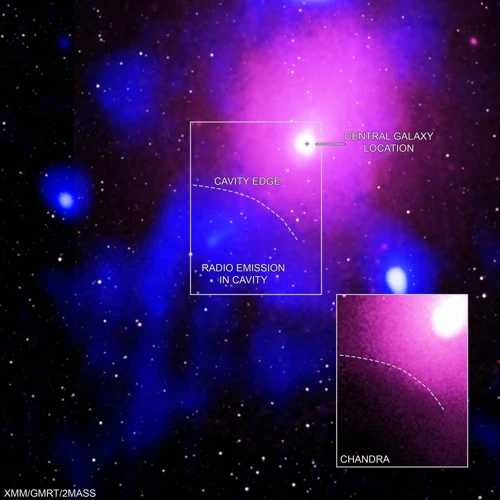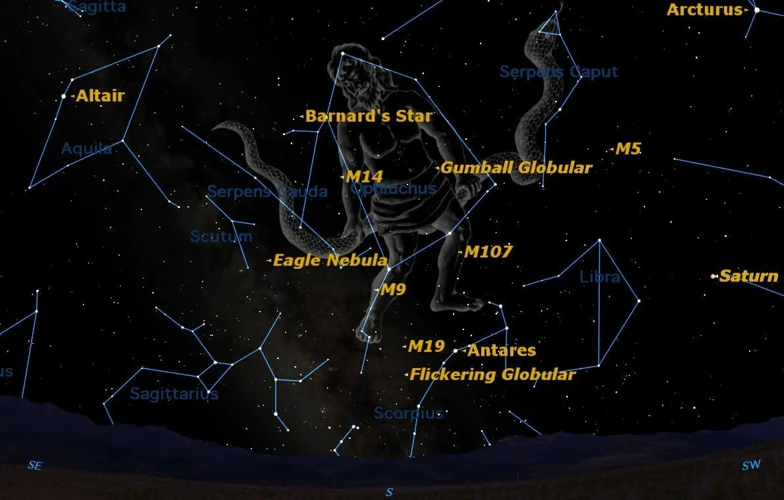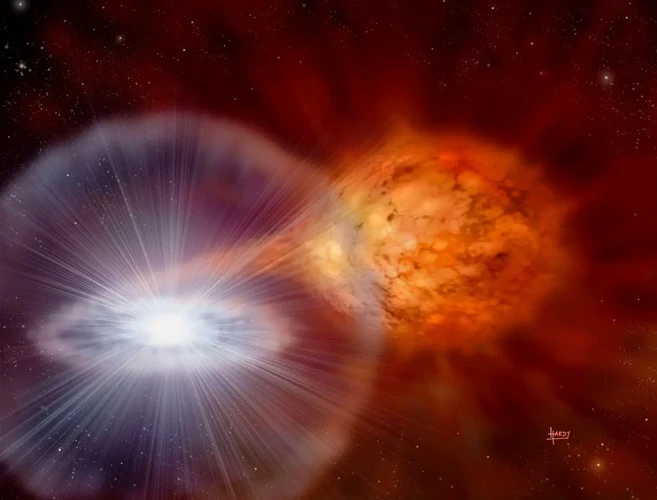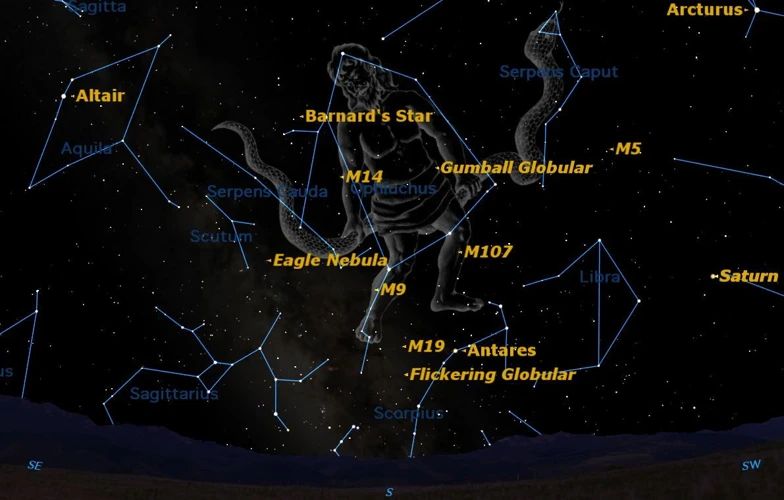White dwarfs, the final stage of low to medium mass stars, are fascinating celestial objects that have captivated the attention of astronomers for centuries. These stellar remnants, which form after a star exhausts its nuclear fuel, hold many secrets about the evolution of stars and the universe as a whole. In this article, we will take a closer look at the formation, characteristics, and significance of white dwarfs, as well as the observations and discoveries that have expanded our understanding of these enigmatic objects. Join us on this cosmic journey as we delve into the intriguing world of white dwarfs.
Contents
- Formation of White Dwarfs
- Characteristics of White Dwarfs
- White Dwarfs in Stellar Evolution
- Observations and Discovery
- Applications and Significance
- Conclusion
-
Frequently Asked Questions
- 1. How long does it take for a star to become a white dwarf?
- 2. Do all stars become white dwarfs?
- 3. Are white dwarfs visible to the naked eye?
- 4. How small are white dwarfs?
- 5. What colors are white dwarfs?
- 6. What elements make up the composition of white dwarfs?
- 7. Do white dwarfs have high gravitational pull?
- 8. How do white dwarfs produce energy?
- 9. Can white dwarfs explode?
- 10. What is the significance of studying white dwarfs?
- References
-
Frequently Asked Questions
- 1. What is the formation process of white dwarfs?
- 2. How do stars go through the stages leading to becoming a white dwarf?
- 3. What are the characteristics of white dwarfs?
- 4. How does the mass and size of a white dwarf affect its characteristics?
- 5. What is the composition and density of white dwarfs?
- 6. How do white dwarfs release energy?
- 7. What happens to low to medium mass stars at the end of their lifecycle?
- 8. What other stellar remnants coexist with white dwarfs?
- 9. How did astronomers pioneer the discovery of white dwarfs?
- 10. How do white dwarfs contribute to our understanding of stellar evolution?
- References
- Read More
Formation of White Dwarfs

The birth of a star is a mesmerizing cosmic event marked by the collapse of a dense gas and dust cloud, known as a nebula. As gravity relentlessly pulls the nebula inward, it begins to spin faster and flatten into a rotating disk, called the protoplanetary disk. Within this disk, regions of higher density form, known as protostellar cores. These cores continue to contract and heat up, eventually reaching a critical threshold where nuclear fusion begins. The release of immense heat and energy from fusion counteracts gravity, creating a delicate balance that sustains the star’s existence for millions or even billions of years. However, this balance is temporary for low to medium mass stars like our Sun. Over time, as the star exhausts its nuclear fuel, its core undergoes gravitational collapse. This collapse triggers a violent explosion known as a supernova, where the outer layers of the star are ejected into space. What remains is the dense core of the star, which becomes a white dwarf. The formation of white dwarfs is a crucial step in the life cycle of stars, leading to further cosmic phenomena such as the birth of neutron stars and black holes. It is a fascinating process that sheds light on the mysteries of the universe and our place within it.
The Birth of a Star
The birth of a star is a complex and awe-inspiring process that begins with the collapse of a nebula. Within a nebula, gravity starts to pull gas and dust together, causing the cloud to become denser and hotter. As the material continues to collapse, the core begins to form. This core, also known as a protostar, grows hotter and denser over time. Eventually, the temperature and pressure at its core reach a critical point, known as the ignition temperature, where nuclear fusion reactions can occur. These fusion reactions involve hydrogen atoms fusing together to form helium, releasing a tremendous amount of energy in the process. This energy, in the form of light and heat, counteracts the inward pull of gravity, creating a stable equilibrium known as hydrostatic equilibrium. It is at this point that a star is born, radiating energy out into space and illuminating its surroundings.
Throughout their lifetimes, stars continue to burn through their nuclear fuel, transforming lighter elements into heavier ones through fusion reactions. The exact life cycle of a star depends on its mass, with high-mass stars burning through their fuel more rapidly than low-mass stars. Regardless of their mass, however, all stars eventually exhaust their nuclear fuel and begin to undergo changes that lead to their final stages of evolution. In the case of low to medium mass stars like our Sun, this evolution culminates in the formation of white dwarfs.
The journey from the collapse of a nebula to the formation of a white dwarf is a mesmerizing spectacle that offers insights into the delicate balance between gravity and the forces of energy that shape the universe. It is a reminder of the vastness and intricacies of the cosmos, inviting us to ponder our place within the grand tapestry of existence.
Evolutionary Stages Leading to a White Dwarf
The evolutionary stages leading to the formation of a white dwarf are a complex and intricate process that spans billions of years. It begins with a protostar, a young and still-forming star, which gradually evolves into a main-sequence star like our Sun. During this phase, hydrogen atoms in the star’s core undergo nuclear fusion, converting them into helium and releasing vast amounts of energy in the process. This fusion process sustains the star’s stability and radiates energy into space in the form of light and heat. As the star ages, however, it starts depleting its hydrogen fuel, causing the core to contract due to gravitational forces. This contraction increases both temperature and pressure in the core, allowing helium fusion to occur, which leads to the formation of heavier elements like carbon and oxygen. The outer layers of the star expand and start glowing brightly, transforming the star into a red giant. This stage is short-lived, and eventually, the star loses its outer layers through stellar winds or a violent ejection known as a planetary nebula. The remaining core, composed of carbon and oxygen, becomes a white dwarf. White dwarfs are incredibly dense, with masses comparable to the Sun but sizes similar to that of Earth. They are held together by electron degeneracy pressure, with the electrons in the core preventing further collapse. The journey from a protostar to a white dwarf encompasses various cosmic stages, each contributing to the intricate tapestry of stellar evolution.
Characteristics of White Dwarfs

White dwarfs possess a unique set of characteristics that distinguish them from other celestial objects. Let’s delve into the key features that define these enigmatic stellar remnants:
Mass and Size: White dwarfs are incredibly dense, packing a mass comparable to that of the Sun into a size roughly equivalent to the Earth. This high density is a result of the gravitational collapse that occurs during their formation.
Temperature and Color: White dwarfs exhibit a wide range of temperatures, with hotter white dwarfs appearing bluish-white and cooler ones appearing reddish-white. The temperature is directly linked to the age of the white dwarf, with younger white dwarfs being hotter than older ones.
Composition and Density: The composition of white dwarfs primarily consists of carbon and oxygen nuclei, densely packed together in a state known as a degenerate matter. This matter is unique in that it defies the usual relationship between pressure and density in most materials.
Luminosity and Energy Output: White dwarfs emit a faint glow of residual thermal energy, known as their luminosity. While they are much dimmer than main-sequence stars, their energy output is relatively stable and sustained by the process of electron degeneracy pressure that counterbalances gravity.
Understanding these characteristics is crucial for unraveling the mysteries of white dwarfs and their role in stellar evolution. They provide a glimpse into the fascinating world of compact stellar remnants and offer insights into the dynamics of the universe.
Mass and Size
Mass and size are defining characteristics of white dwarfs, dictating their structure and behavior. White dwarfs are incredibly dense objects, with masses comparable to that of the Sun or even greater. Despite their high mass, white dwarfs are relatively small in size, typically ranging from about the size of the Earth to slightly larger. This compactness is a result of intense gravitational forces that compress the material in the star’s core. The mass and size of a white dwarf are intricately connected, as the gravitational force depends on the mass of the star. A higher mass white dwarf will have a smaller size due to the stronger gravitational pull. Conversely, a lower mass white dwarf will be larger. The relationship between mass and size in white dwarfs is governed by the physics of degeneracy pressure, where the electrons in the star’s core become tightly packed and resist further compression. It is this delicate balance between gravity and the electron degeneracy pressure that determines the final mass and size of a white dwarf. Understanding the mass and size of white dwarfs provides valuable insights into their formation, evolution, and overall behavior within the cosmic landscape.
Temperature and Color
The temperature and color of white dwarfs are intimately related and provide valuable insights into these stellar remnants. As a white dwarf forms, it begins as an incredibly hot object, with temperatures reaching tens of thousands of degrees Celsius. However, over time, it cools down and fades. The temperature of a white dwarf is determined by its age, with younger white dwarfs being hotter than older ones. The color of a white dwarf is directly linked to its temperature, following a pattern known as blackbody radiation. At high temperatures, white dwarfs emit a bluish-white light, similar to the hottest stars in the universe. As the white dwarf cools, its color transitions to yellow, then orange, and finally to a dim reddish hue. These color changes correspond to decreasing temperatures and reflect the evolution of the white dwarf. Studying the temperature and color of white dwarfs provides astronomers with invaluable information about their age, composition, and past evolutionary history. It allows us to unravel the mysteries of these cosmic remnants and gain a deeper understanding of the intricate workings of the universe.
Composition and Density
Composition and density are two important characteristics that define white dwarfs. These stellar remnants are composed mainly of carbon and oxygen, with trace amounts of other elements such as helium and hydrogen. The composition of a white dwarf is a result of the nuclear fusion processes that occurred during its earlier stages as a main sequence star. As the star ages, it consumes its hydrogen and helium fuel and begins to burn heavier elements like carbon and oxygen. This ash of nuclear fusion accumulates in the core of the star, forming the dense remains of a white dwarf.
The density of white dwarfs is remarkably high, with an average density about a million times denser than Earth. To put this into perspective, a teaspoon of white dwarf material would weigh several tons. This incredible density is a consequence of the gravitational collapse that occurs during the formation of a white dwarf. The core of the star becomes so compressed that atomic nuclei are pushed together, creating a state of matter known as electron degeneracy. In this state, electrons are tightly packed and can no longer move freely, resulting in a counterintuitive effect where increased pressure leads to increased density.
The composition and density of white dwarfs play a crucial role in shaping their physical properties and behavior. They are key factors in determining the size, mass, and overall stability of these celestial objects. Understanding the composition and density of white dwarfs provides valuable insights into stellar evolution and the complex dynamics of the universe. It is through studying these compact remnants that scientists are able to unravel the mysteries that lie within the final stages of low to medium mass stars.
Luminosity and Energy Output
Luminosity refers to the amount of energy emitted by a celestial object per unit of time. When it comes to white dwarfs, their luminosity is an essential characteristic that provides insights into their energy output. The luminosity of a white dwarf primarily depends on its temperature and surface area. Due to their small size and high temperatures, white dwarfs have relatively low luminosities compared to main sequence stars. However, their energy output is not constant but gradually diminishes over time. This decrease in luminosity is a consequence of the white dwarf’s cooling process as it radiates away its remaining thermal energy. As white dwarfs cool down, their luminosity decreases, and they transition from being hot and bright to fainter and cooler. This gradual fading of luminosity allows astronomers to estimate the age of a white dwarf by comparing its brightness to theoretical models of stellar evolution. It is through the study of luminosity and energy output of white dwarfs that scientists gain valuable insights into the aging process and ultimate fate of these stellar remnants.
White Dwarfs in Stellar Evolution

White dwarfs play a crucial role in stellar evolution, representing the final stage of low to medium mass stars. As these stars exhaust their nuclear fuel, they undergo a series of transformative stages that eventually lead to the formation of white dwarfs. Once a supernova explosion occurs, the outer layers of the star are ejected, leaving behind a dense, hot core. With the outer layers removed, the gravitational pull on the core increases, causing it to collapse in on itself. This collapse results in a highly compact object, approximately the size of Earth but with a mass comparable to that of the Sun. These white dwarfs are incredibly dense, with matter packed tightly together. Their high density, along with the lack of nuclear fusion in their cores, causes them to cool and fade over time. Despite their small size, white dwarfs can still exert a significant gravitational pull, affecting nearby objects and even creating gravitational lenses. They are integral to the understanding of stellar evolution, providing valuable insights into the life cycles of stars and the complex processes that shape our universe.
The Fate of Low to Medium Mass Stars
The fate of low to medium mass stars is a remarkable journey through stellar evolution. These stars, like our Sun, undergo a series of transformations before reaching their final stage as white dwarfs. As a star’s nuclear fuel begins to deplete, the core contracts under gravity, causing the outer layers of the star to expand and cool. This phase is known as the red giant phase, where the star swells in size and becomes thousands of times larger than its original form. Eventually, the outer layers are expelled into space in a beautiful display known as a planetary nebula. What remains is the hot, dense core of the star, which becomes a white dwarf. The fate of low to medium mass stars is in stark contrast to their more massive counterparts, which undergo even more intense gravitational collapse, leading to the formation of neutron stars or black holes. Studying the fate of these stars helps us understand the different paths that stars can take and provides valuable insights into the life cycles of celestial objects.
Stellar Remnants: White Dwarfs, Neutron Stars, and Black Holes
When low to medium mass stars reach the end of their lives, they go through a remarkable transformation, leaving behind various stellar remnants such as white dwarfs, neutron stars, and black holes. White dwarfs, as we discussed earlier, are the remnants of stars that have exhausted their nuclear fuel and undergone a supernova explosion. These compact objects are composed mostly of electron-degenerate matter, packed tightly together due to gravity. Neutron stars, on the other hand, are even denser and smaller than white dwarfs. They are formed when the core of a massive star collapses under gravity, causing protons and electrons to merge and form neutrons. Neutron stars can be incredibly dense, with a mass greater than that of the Sun packed into a sphere only about 10 kilometers in diameter. Lastly, black holes represent the most extreme form of stellar remnant. They are formed when the core of a massive star collapses to a singularity, creating an infinitely dense point with gravitational forces so strong that not even light can escape their gravitational pull. These stellar remnants, each with its own unique properties and characteristics, provide valuable insights into the fundamental nature of space, time, and gravity. It is truly awe-inspiring to contemplate the existence of these cosmic phenomena and the profound mysteries they embody.
Observations and Discovery

Observing and discovering white dwarfs has been a remarkable journey for astronomers throughout history. Pioneering astronomers played a crucial role in the identification and understanding of these celestial objects. One of the earliest groundbreaking observations was made by the British astronomer William Herschel in 1783, who cataloged a white dwarf known as 40 Eridani B. However, it wasn’t until the early 20th century that the true nature of white dwarfs began to be unraveled. In 1914, the American astronomer Walter Adams and his colleague Theodore Dunham identified the first spectroscopic white dwarf, known as Sirius B. This observation provided solid evidence of the existence of these compact remnants. Another significant contribution was made by the Dutch astronomer Ejnar Hertzsprung, who in 1915 discovered the correlation between the color and luminosity of stars, now known as the Hertzsprung-Russell diagram. This diagram played a pivotal role in identifying and classifying white dwarfs based on their temperature and luminosity. In more recent times, the exploration of white dwarf systems in binary star systems has shed further light on their properties. The Kepler space telescope, launched by NASA in 2009, has been instrumental in detecting and studying white dwarf pulsators, providing valuable data on their internal structure and evolution. These observations and discoveries have deepened our understanding of the life cycles of stars and the cosmic processes that give rise to white dwarfs. They have allowed us to uncover the intricate mysteries of these stellar remnants and their significance in shaping our universe.
Pioneering Astronomers
Pioneering astronomers played a crucial role in the discovery and understanding of white dwarfs. One such notable figure is Subrahmanyan Chandrasekhar, an Indian-American astrophysicist, who made significant contributions to our understanding of stellar evolution. In the early 20th century, Chandrasekhar proposed a theoretical limit known as the Chandrasekhar limit, which describes the maximum mass a white dwarf can have before it undergoes further collapse. This groundbreaking work earned him the Nobel Prize in Physics in 1983. Another important figure in the study of white dwarfs is Cecilia Payne-Gaposchkin, an American astronomer who was the first to suggest that white dwarfs are primarily composed of helium and carbon. Her research paved the way for a deeper understanding of the composition and structure of these celestial objects. Over the years, many other astronomers have made significant contributions to our knowledge of white dwarfs, further unraveling their mysteries and expanding our understanding of the universe. The work of these pioneering astronomers continues to inspire and guide current and future generations of scientists in their quest to explore the cosmos.
White Dwarfs in Binary Systems
White dwarfs in binary systems present a fascinating astronomical phenomenon that has captured the interest of scientists and astronomers. Binary systems are composed of two stars that orbit around a common center of mass. In some cases, one of the stars in the binary system evolves into a white dwarf, creating a unique celestial dance.
One intriguing scenario involves a white dwarf and a companion star, typically a main sequence star or another white dwarf. As they orbit each other, the companion star can transfer mass onto the white dwarf through a process called accretion. This transfer of mass can occur through stellar winds or via a process known as Roche lobe overflow, where the companion star fills its Roche lobe and material spills onto the white dwarf.
Accretion onto a white dwarf can have profound consequences. As the white dwarf gains mass, it approaches a critical limit known as the Chandrasekhar limit, which is approximately 1.4 times the mass of the Sun. Once the white dwarf surpasses this limit, a catastrophic event known as a type Ia supernova occurs. In this explosive event, the white dwarf undergoes a runaway nuclear fusion reaction, releasing an enormous amount of energy and ejecting its outer layers into space.
The significance of white dwarfs in binary systems lies in their role as cosmic laboratories for studying stellar evolution, accretion processes, and the physics of supernovae. By observing these systems, astronomers can gain insights into the mechanisms behind these transformative events and deepen our understanding of the universe.
White dwarfs in binary systems offer a captivating glimpse into the complex interactions and dynamics of celestial objects. Their study provides invaluable knowledge about stellar evolution and the intricate mechanisms that govern the fate of stars in our vast cosmos.
Applications and Significance

Understanding the applications and significance of white dwarfs is essential in unraveling the mysteries of stellar evolution and the cosmos. Firstly, studying white dwarfs provides valuable insights into the life cycles of stars. By examining the characteristics and behavior of these stellar remnants, astronomers can refine their understanding of the processes that lead to the formation of white dwarfs, as well as the subsequent stages such as neutron stars and black holes. This knowledge contributes to our overall comprehension of how the universe evolves over time. White dwarfs serve as cosmic clocks, allowing scientists to estimate the age of star clusters and galaxies. Since white dwarfs cool down over time, measuring their temperatures can provide crucial information about the age of the stellar population they belong to. This knowledge helps refine our understanding of the history and evolution of galaxies, providing vital clues about the origins and development of the universe itself. The applications and significance of white dwarfs reach far beyond their own existence, making them indispensable tools in our ongoing quest to decipher the secrets of the cosmos.
Understanding Stellar Evolution
Understanding stellar evolution is crucial for unraveling the mysteries of the universe and gaining insights into the broader processes that shape our cosmos. By studying the life cycles of stars, astronomers can piece together a timeline of events that lead to the formation of structures such as white dwarfs. Stellar evolution encompasses the various stages a star goes through, from its birth as a collapsing nebula to its final phase as a white dwarf or other stellar remnant. Through observations and theoretical models, scientists have been able to trace the different paths that stars can take based on their initial mass. The fate of low to medium mass stars, like our Sun, involves the formation of a white dwarf. This understanding allows us to comprehend the characteristics and behaviors of white dwarfs, providing valuable insights into the structure, composition, and dynamics of these stellar remnants. Studying stellar evolution helps us grasp the interconnectedness of celestial phenomena and deepen our appreciation for the vastness and complexity of the universe we inhabit.
White Dwarfs as Cosmic Clocks
White dwarfs, with their stable and predictable nature, serve as invaluable cosmic clocks in the study of stellar evolution and the age of the universe. These dense stellar remnants, formed from the remnants of low to medium mass stars, offer astronomers a glimpse into the past. By analyzing the cooling rate of white dwarfs, scientists can estimate the time since they were formed. The process is akin to observing a cup of hot coffee gradually cooling down in a room. As white dwarfs lose their thermal energy over time, their brightness decreases, and their colors shift towards the redder end of the spectrum. Through careful observations and calculations, astronomers can determine the initial temperature of the white dwarf and infer its age. This age estimation technique, known as white dwarf dating, has proven to be remarkably reliable in determining the ages of star clusters and galaxies. Additionally, studying the composition of white dwarfs provides valuable insights into the chemical evolution of the universe, as these objects retain the elements synthesized during their progenitor stars’ lifetimes. With their cosmic timekeeping abilities, white dwarfs unlock the secrets of the universe’s past, giving us a deeper understanding of our cosmic origins and the passage of time itself.
Conclusion

In conclusion, white dwarfs represent the final stage in the evolution of low to medium mass stars. These intriguing stellar remnants offer valuable insights into the life cycles of stars and the dynamics of the universe. Through the study of white dwarfs, astronomers have deepened their understanding of stellar evolution, uncovering the processes that lead to the formation of these dense objects. Furthermore, white dwarfs serve as cosmic clocks, providing astronomers with crucial age estimates for star clusters and galaxies. The observations and discoveries made by pioneering astronomers have paved the way for further exploration of white dwarfs and their role in the cosmos. As we continue to unravel the mysteries of these celestial objects, we come closer to comprehending the immense beauty and complexity of the universe we inhabit.
Frequently Asked Questions

1. How long does it take for a star to become a white dwarf?
The duration of a star’s journey to becoming a white dwarf depends on its initial mass. On average, it takes about 10 billion years for a star with the mass of our Sun to reach the white dwarf stage.
2. Do all stars become white dwarfs?
No, not all stars become white dwarfs. Only low to medium mass stars, ranging from about 0.1 to 8 times the mass of our Sun, go through the white dwarf stage. Higher mass stars will undergo different fates, such as becoming neutron stars or black holes.
3. Are white dwarfs visible to the naked eye?
White dwarfs are extremely faint and are generally not visible to the naked eye. They emit most of their energy in the form of invisible ultraviolet radiation. However, some white dwarfs in binary systems can be observed indirectly by studying their effects on their companion star.
4. How small are white dwarfs?
White dwarfs are incredibly dense, but their size is relatively small. They have a typical size comparable to that of the Earth, despite containing a mass comparable to that of the Sun. This means they are incredibly dense, with a teaspoonful of their material weighing several tons.
5. What colors are white dwarfs?
Despite their name, white dwarfs can have a range of colors. Some can appear bluish-white, while others may have a yellowish or reddish hue. The color of a white dwarf depends on its temperature, with hotter ones appearing bluer and cooler ones appearing redder.
6. What elements make up the composition of white dwarfs?
White dwarfs primarily consist of carbon and oxygen, which are the remnants of nuclear fusion reactions that occurred during the star’s main sequence phase. Some white dwarfs also contain traces of helium, hydrogen, and other elements, but the majority of their mass is carbon and oxygen.
7. Do white dwarfs have high gravitational pull?
Yes, despite their small size, white dwarfs have an incredibly high gravitational pull. In fact, their gravitational force is around 100,000 times stronger than that of Earth. The massive gravitational pull is a result of their high density and compact nature.
8. How do white dwarfs produce energy?
White dwarfs do not generate energy through nuclear fusion like main sequence stars. Instead, they rely on residual heat left over from their earlier stages. Over time, they gradually cool down and release this stored thermal energy into space, eventually becoming dimmer and transitioning into black dwarfs.
9. Can white dwarfs explode?
While white dwarfs themselves do not explode, they can undergo a catastrophic event called a Type Ia supernova. This occurs when a white dwarf in a binary system accretes matter from its companion star, crossing a critical threshold known as the Chandrasekhar limit. The sudden release of energy triggers a thermonuclear explosion, completely destroying the white dwarf.
10. What is the significance of studying white dwarfs?
Studying white dwarfs provides valuable insights into the life cycle of stars, stellar evolution, and the fate of our own Sun. They act as cosmic clocks, helping astronomers estimate the ages of star clusters and galaxies. White dwarfs also serve as laboratories for testing theories of stellar structure and the behavior of matter under extreme conditions.
References
Frequently Asked Questions

1. What is the formation process of white dwarfs?
White dwarfs are formed through the evolution of low to medium mass stars, where the outer layers are ejected as a planetary nebula, leaving behind a dense core.
2. How do stars go through the stages leading to becoming a white dwarf?
Stars go through several evolutionary stages before becoming a white dwarf. These stages include the main sequence, red giant phase, and planetary nebula phase.
3. What are the characteristics of white dwarfs?
White dwarfs are relatively small and dense, with masses comparable to the Sun but sizes similar to the Earth. They possess high temperatures, typically ranging from 8,000 to 40,000 degrees Celsius, and emit a wide spectrum of colors.
4. How does the mass and size of a white dwarf affect its characteristics?
A higher mass of a white dwarf results in a smaller size and a higher surface gravity. This, in turn, leads to higher densities and temperatures. The mass also determines the eventual fate of the white dwarf.
5. What is the composition and density of white dwarfs?
White dwarfs are composed mainly of carbon and oxygen, with traces of other elements. They have incredibly high densities, with a teaspoon-sized amount of white dwarf material weighing around several tons.
6. How do white dwarfs release energy?
White dwarfs release energy through residual heat from their formation and ongoing thermonuclear reactions. These reactions drive the luminosity of the white dwarf, resulting in its observed brightness.
7. What happens to low to medium mass stars at the end of their lifecycle?
At the end of their lifecycle, low to medium mass stars shed their outer layers and form a white dwarf. The remaining core undergoes compression, leading to a stable, degenerate state.
8. What other stellar remnants coexist with white dwarfs?
In addition to white dwarfs, stellar remnants can include neutron stars and black holes, depending on the mass of the original star. Neutron stars form from more massive stars than white dwarfs, while black holes result from extremely massive stars.
9. How did astronomers pioneer the discovery of white dwarfs?
Pioneering astronomers, such as Subrahmanyan Chandrasekhar and Arthur Eddington, made significant contributions to understanding white dwarfs. Chandrasekhar’s work on the theoretical limit of white dwarf mass earned him the Nobel Prize in Physics.
10. How do white dwarfs contribute to our understanding of stellar evolution?
Studying white dwarfs provides insights into the final stages of a star’s life. They help scientists understand the processes of stellar evolution, including nucleosynthesis, supernovae, and the formation of other stellar remnants.
References
- 23.1 The Death of Low-Mass Stars
- White dwarfs: Facts about the dense stellar remnants
- Lecture 17: Evolution of Low Mass Stars







